

Well-Safe Solutions, a global energy transition specialist, has appointed a new Country Manager for the Malaysian market in a bid to develop its Asia Pacific presence.
Adrin Shafil, who currents heads up the business in Kuala Lumpur, is the individual given this task and is seeking to leverage his operator, well management and drilling contractor experience in order to fulfil it.
“I’m really excited to be joining Well-Safe Solutions at this key moment in its global growth journey,” he remarked. “I’ve kept up to date with the company’s recent developments, with Well-Safe Solutions Pty continuing to grow at pace in Australia and throughout South-east Asia.
“I’m looking forward to bringing my well plug and abandonment and engineering experience to bear as we continue to service the well abandonment, personnel and project delivery requirements of clients throughout Malaysia, Australia and beyond.”
Shafil will report to Massimo Delia, General Manager – Asia-Pacific, who commented, “Adrin is an ideal fit for our current business, as well as our long-term aspirations to continue growth in the APAC region. His considerable engineering experience and client management skills will bring immediate benefit to our operations – not just in Malaysia, but throughout southeast Asia.”
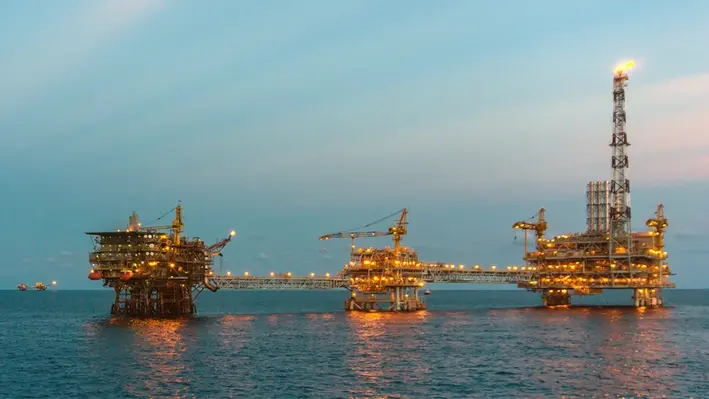

Reservoir Link Energy Bhd. (RLEB), an energy related services provider, has announced that its subsidiary, Reservoir Link Sdn. Bhd. (RLSB), received a letter of award from Hibiscus Oil & Gas Malaysia Limited (HML) for the provision of well leak diagnostic and remedial services.
As per the three-year contract (which has an optional one-year extension), RLSB will supply competent personnel, all consumables, operate associated equipment to perform the sealant treatment activities and execute well integrity remediation activities related to pressure and time activated sealant services (independent equipment and without utilisation of slickline, e-line or coiled tubing unit). This will be for any of HML’s pressure and time activated sealant operations.
This announcement was closely followed by an additional agreement confirmed by a 60% owned subsidiary of RLEB, Reservoir Link Solutions Sdn Bhd. (RLS).
This centred around a memorandum of understanding signed with Ad Terra Asia Sdn. Bhd. In order to mutually collaborate around specialised studies and work in relation to geological storage of carbon capture, utilisation and storage (CCUS) as well as subsurface, geology and geophysical studies in Malaysia.
Both parties have agreed to cooperate in relation to exploring potential business opportunities in the territory and to use reasonable efforts to explore and complete any contract mutually agreed upon. During the term of the MoU, the parties expressed a wise to explore the possibility of promoting, marketing, selling and distributing each other’s products and/or services within the territory for the duration of the agreement (expiring on 25 March 2025).
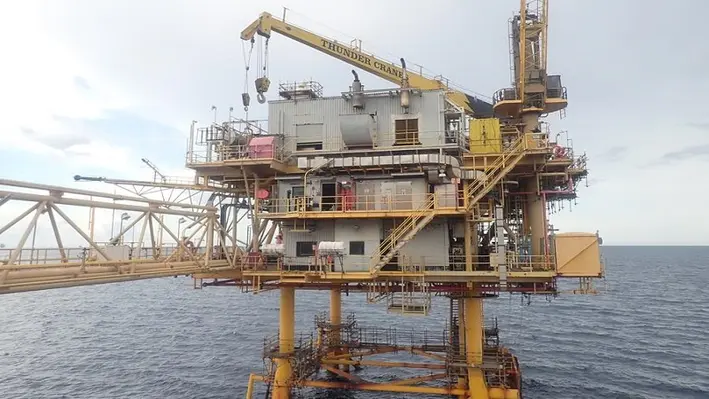

Thunder Cranes, a leading provider of portable, modular, offshore rental cranes with a lift capacity ranging from 2 to 0 tons, has published a case study outlining a successful decommissioning project it helped facilitate in the Gulf of Thailand.
The company was originally engaged by Chevron Thailand to assist in the removal of modules from the topside of a production platform located in the Gulf. This was scheduled prior to the removal of the entire well-head platform by a heavy barge crane. Removing the modules would sufficiently reduce the overall platform weight to within the capacity of the intended barge crane.
The objective of the client was a reverse-installation and backloading of various modules to supply vessel for disposal or recycling and the existing platform crane capacity and reach radius was not sufficient for the project.
Located on the top deck there were 14 large components weighing between 10 to 40 tons, as well as a number smaller components of various weights below 10 tons.
Thunder Cranes proposed the TC90 modular rental crane which has a maximum capacity of 50MT for offboard lifts and this was accepted as the best solution from the viewpoint of ensuring safe, static lifting. Cost and time savings were also to be expected.
According to Thunder Cranes, there were a number of unique challenges that had to be incorporated into the detailed planning of the decommissioning operation. This included the limited space on the platform for rigging up as well as no exposed beams on which the company could apply the TC90 clamping system. To meet this, welding with dog plates was required to tie down the modular crane and this was implemented safely and without issues. In addition, due to limited space on the platform deck, the supply vessel was on standby within reach of the platform crane, allowing the rig up and rig down of the TC90 crane on the fly.
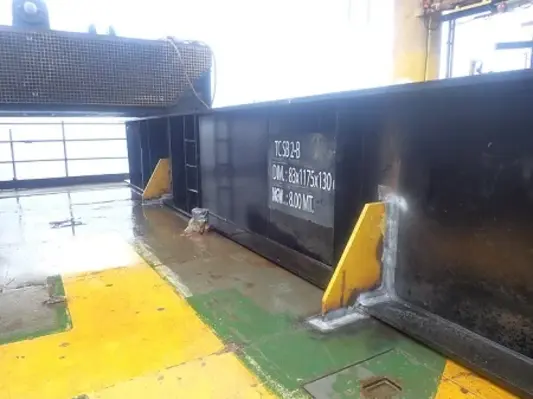
Another hurdle was that some of the larger modules at the limit of the TC90 reach radius did not have verified weight information. As a result, a decision had to be made on whether to reposition the crane for those lifts or whether to disassemble and breakdown down those modules into smaller components. Upon further study it was concluded that the best way forward was to breakdown some of the modules. In addition, Thunder Cranes deployed its most experienced lifting superintendent on site to supervise the most critical lifts.
In order to ensure all the challenges were sufficiently dealt with and the company was able to carry out the project effectively, rigorous planning and assessments were undertaken and actioned. Thunder Cranes’ process for this starts with a thorough assessment of the client’s lifting requirements, platform drawings, general specifications, and project timelines. A site visit is then conducted to verify that an appropriate and practical solution can be proposed.
Its proposal and quotation come with a Site Visit Report to clearly communicate the proposed method with drawings and photos.
After the proposal is given the green light, Thunder Cranes begin the detailed planning stage where it collaborated with the client to customizs elements of the project in terms of materials, equipment, third party services, utilities, scaffolding, etc. Customisation can include any platform modifications if needed, or any re-positioning, or removal of elements from the main deck of the platform.
The company’s modular crane configuration is customised to meet specific needs with regards to the tied down method, boom reach radius, zone rating, or any other safety or environmental considerations.
The next step included engineering work pack submission to the client addressing the specific scope of work and lifting requirements, featuring detailed considerations from the site visit, with comprehensive rig up and lifting plans, customised layout and positioning drawings, as well as reaction force calculations needed to conduct a structural analysis.
Pre-mobilisation planning included risk assessment/hazard identification, and alignment sessions were conducted for offshore personnel to ensure safe and efficient operation of the modular cranes.
For other projects, dependent on location, the preparation and deployment of the modular cranes and auxiliary equipment might begin months ahead to ensure cranes are at the load out port and ready to be transported to the offshore site and assembled according to the pre-planned schedule and project configuration.
According to Thunder Cranes, the project objectives were met successfully to the client’s satisfccation and within schedule. There were no incidents or hinderances recorded during the project which followed a timeline of:
• Load out from port and sailing to platform via supply boat.
• Platform crane lifts TC Modular Crane components to platform for rig up.
• Welding base beam and complete rig up of TC90.
• Inspection and load testing TC90.
• Commence lifting operations.
• Stop operation during heavy monsoon weather.
• Resume lifting operations.
• Rig down TC90 and demob.
By removing the production modules, the overall platform weight was reduced to be within the capacity of the heavy lift vessel which was able to remove the topside and structure in one lift. This marked another successful project carried out by Thunder Cranes.
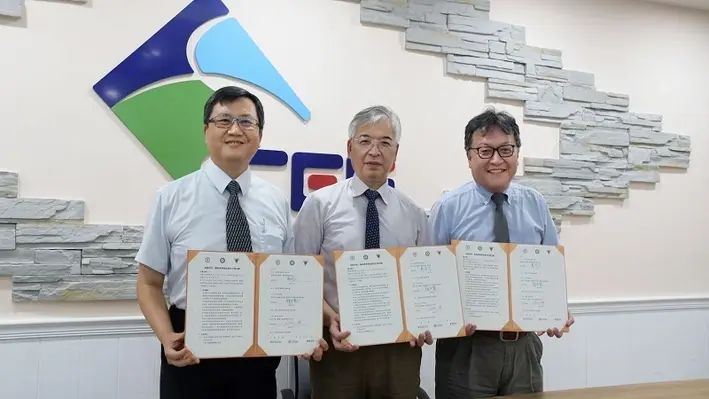
 China Petroleum Coporation of Taiwan (CNPC Taiwan) signed a MoU with Academia Sinica and National Central University for a partnership concerning geothermal research, exploration and development technology collaboration.
China Petroleum Coporation of Taiwan (CNPC Taiwan) signed a MoU with Academia Sinica and National Central University for a partnership concerning geothermal research, exploration and development technology collaboration.
The MoU comes in response the Taiwanese Government’s energy and transformation policy as well as the desire to actively promote research and development of green energy and carbon reduction technologies across multiple industries.
In recent years, CNPC China has been searching for collaboration teams in order to cooperate with the national energy transformation policy. Academia Sinica is the country’s highest academic research institution, housing the Institute of Geosciences which masters advanced geological, geochemical and geophysical related survey data and analysis technologies. Central University has the School of Geosciences and the Carbon Sequestration and Geothermal Research Center.
The collaborative aim is to promote geothermal research and exploration technology within Taiwan in a bid to be net-zero by 2050.

 Ahead of the D&A APAC 2024 Conference, set to open its doors in Kuala Lumpur from 12-13 November, Offshore Network has released its Asia Pacific Decommissioning and Abandonment Outlook which reviews the region’s current liabilities and the key players who are undertaking the oncoming decommissioning storm.
Ahead of the D&A APAC 2024 Conference, set to open its doors in Kuala Lumpur from 12-13 November, Offshore Network has released its Asia Pacific Decommissioning and Abandonment Outlook which reviews the region’s current liabilities and the key players who are undertaking the oncoming decommissioning storm.
The countdown is on for Southeast Asia to stay ahead of what promises to be a prosperous decommissioning market in the decades to come. As many of the region’s upstream assets wave goodbye to their productive years, D&A liabilities continue to tally up meaning the once-distant thought of decommissioning is now firmly at the forefront.
According to Petronas’ Activity Outlook 2021-2023, within Malaysia there are more 3,000 wells in which 45% are idle, with over 500 scheduled to be permanently plugged by 2030. Wood Mackenzie has previously reported that Southeast Asia’s offshore assets, amounting of 2,600 platforms and a staggering 35,000 wells, will eventually need to undergo decommissioning services.
Due to the sheer scope of D&A work in the years ahead, emphasise is being placed on the growing need for knowledge sharing and collaboration throughout the region. With collaboration comes the implementation of innovative technology and more opportunities to reap prosperous results akin to those seen in the North Sea and Gulf of Mexico.

 Following encouraging results from extensive surveys, INPEX Corporation has decided to go ahead with exploratory drilling for geothermal energy development in Shibetsu Town, Hokkaido, Japan.
Following encouraging results from extensive surveys, INPEX Corporation has decided to go ahead with exploratory drilling for geothermal energy development in Shibetsu Town, Hokkaido, Japan.
Since its nomination in the process of the 'Selection of Operators for the Musadake Region Geothermal Survey' in Shibetsu Town in 2020, INPEX has been conducting surface and geophysical surveys as well as drilling operations in the Sempo area northwest of Mount Musadake in the western part of Shibetsu Town. It took a positive turn as the company came across geothermal resources from the site, which can potentially actualise its net zero ambitions while expanding its clean energy business in Japan.
INPEX aims to accelerate its geothermal initiatives by tapping into the technologies it cultivated through oil and natural gas development. The company has plans to proactively engage in energy landscape development to help
realise a net zero carbon society while fulfilling its responsibilities for the stable development and supply of energy.
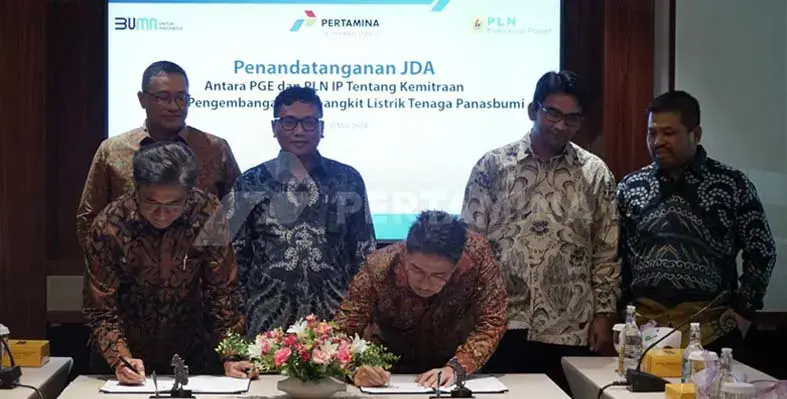
 In a drive to leverage Indonesia's vast geothermal poetntial, PT Pertamina Geothermal Energy Tbk and PT PLN Indonesia Power have signed a joint development agreement (JDA) in Jakarta to optimise the capacity of several geothermal power plants (PLTP) in the country.
In a drive to leverage Indonesia's vast geothermal poetntial, PT Pertamina Geothermal Energy Tbk and PT PLN Indonesia Power have signed a joint development agreement (JDA) in Jakarta to optimise the capacity of several geothermal power plants (PLTP) in the country.
This JDA comes after the joint development study agreement (JDSA) that the companies signed in February.
Julfi Hadi, President Director of PT Pertamina Geothermal Energy Tbk, said, "The signing of this JDA demonstrates our strong commitment to increasing the utilisation of Indonesia's abundant geothermal resources to support the acceleration of the national energy transition, achieve the government's commitment to the Enhanced National Determined Contribution (NDC), and the Net Zero Emission programme in Indonesia. We believe this cooperation will accelerate the development of more efficient and sustainable geothermal projects as one of PGE's strategic efforts to achieve 1 GW in the next two years."
The JDA primarily aims to develop co-generation projects in two geothermal working areas. The approach will involve utilisation of brine or hot water from steam separation, to stimulate electricity production.
The initial target for the PLTP Co-Generation (Binary Plant) development is in the Ulubelu Binary Unit and Lahendong Binary Unit PLTP areas, potentially adding 30 MW and 15 MW of installed capacity, respectively.
Noting that the initiative can increase PGE's installed capacity by up to 230 MW, Hadi said, "This JDA allows us to focus on increasing electricity capacity and accelerating geothermal energy development as part of the national energy transition strategy. By applying principles of operational excellence, we ensure that every stage from development to project operation is carried out efficiently and with the highest quality, thereby increasing the use of renewable energy."
Following the success of the JDA, the PGE and PLN IP will soon make effective a power purchase agreement (PPA). "We hope this JDA can serve as an example for other renewable energy projects in Indonesia. With strong synergy and collaboration, we can achieve our goal of creating a more sustainable energy future," Hadi said.
Also present at the JDA signing was Norman Ginting, Project and Operations Director of Pertamina New & Renewable Energy (Pertamina NRE), who appreciated and hoped that this collaboration and synergy could continue. "Today, Pertamina through PGE and PLN through PLN IP have successfully signed a JDA as an important milestone for geothermal development. Pertamina NRE highly appreciates this step and hopes that in the future, these two important national energy SOEs can collaborate and synergise to drive more massive decarbonisation," Ginting said.
Vice President of Corporate Communication of PT Pertamina (Persero), Fadjar Djoko Santoso, said, "Geothermal development is an effort to support the Government in achieving the national energy mix target and also Pertamina's effort in developing New Renewable Energy."
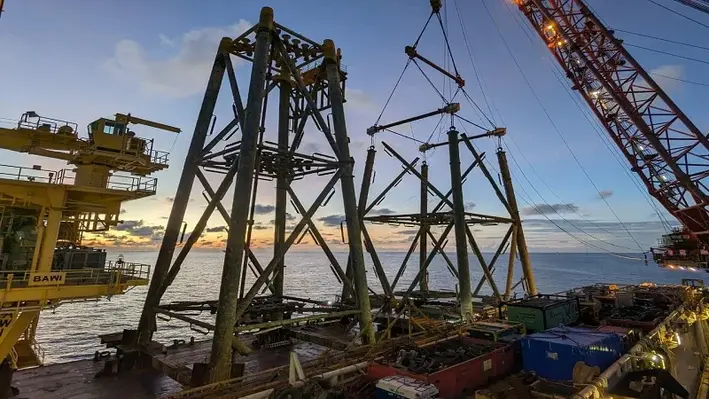

James Fisher Decommissioning, part of James Fisher and Sons plc, has completed a significant decommissioning project in the Gulf of Thailand.
After extending the contract with a major offshore engineering, preparations, removal and disposal (EPRD) operator, the project became the largest to date for James Fisher, involving the removal of 25 offshore jackets in support of the client’s wider asset end-of-life campaign.
James Fisher was able to support the client through the expertise of its in-house decommissioning team and equipment, including abrasive waterjet cutting, hydraulic demolition shears and diamond wire saws.
To complete the multi-million-pound project, the decommissioning specialist utilised abrasive cut verification technology which ensured operations are completed successfully on the first attempt and without the need to re-evaluate the initial cut. It is estimated that, by improving efficiency of the operations in this way, cutting time was reduced by 50%.
“We pride ourselves on providing bespoke, environmentally focused solutions to overcome some of the most complex decommissioning structures faced by our customers,” Mark Stephen, Decommissioning Director for James Fisher, remarked. “This type of operation was a first for James Fisher Decommissioning in terms of jacket removal volume and duration, and we are extremely proud to have been part of the project. Utilising our strong in-house decommissioning capabilities and real-time monitoring technology, we saved valuable project time during the cutting process while ensuring the project was completed to the highest standards for our client.”
This represents the latest success for the company since the launch of the decommissioning business line.
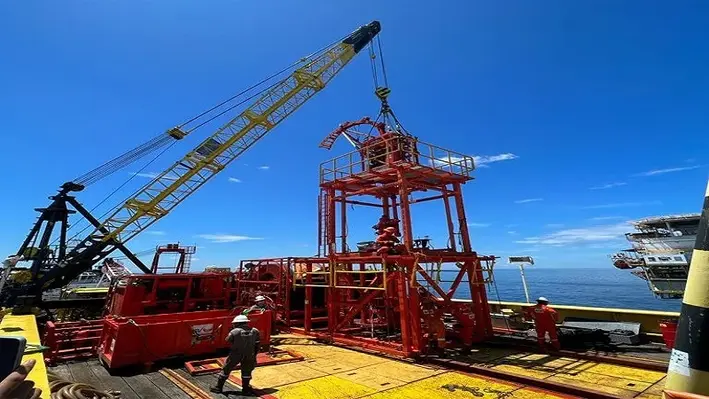
 Working for a prominent energy company, offshore lifting solutions provider Thunder Cranes offered mobilising its small-footprint, portable modular crane on a small supply vessel to the work site.
Working for a prominent energy company, offshore lifting solutions provider Thunder Cranes offered mobilising its small-footprint, portable modular crane on a small supply vessel to the work site.
After reaching the site, it can be rigged up, load tested, and prepared for lifting operations, all in a day, rather than going with the costly option of a barge or vessel crane, which can also render ineffectual.
While the project involved challenges from limited deck space to heavy lifting requirements, Thunder Cranes was well-equipped to tackle them with its compact, hydraulic powerpack/prime mover, TC20 stiff leg crane with a 60-ft boom length, and a 'self-lifting' package of TC's proprietary.
The choices of equipment and services by Thunder Cranes were reached post a thorough assessment of the client's lifting requirements, platform drawings, general specifications, and project timelines. This was followed by a site visit for verification, which became the basis for practical solutions.
The energy company required solutions with their offshore coiled tubing operations that involved the lifting of their CTU equipment onto their offshore platform which only had a small jib crane of 1.8-ton capacity, while the coiled tubing reel itself weighed 16 tons. Thunder Crane's modern approach with its portable-modular crane technology instead of the traditional large vessel or barge crane helped its client to optimise their logistics and enhance project uptime, while maintaining a high level of safety and cost-effectiveness.
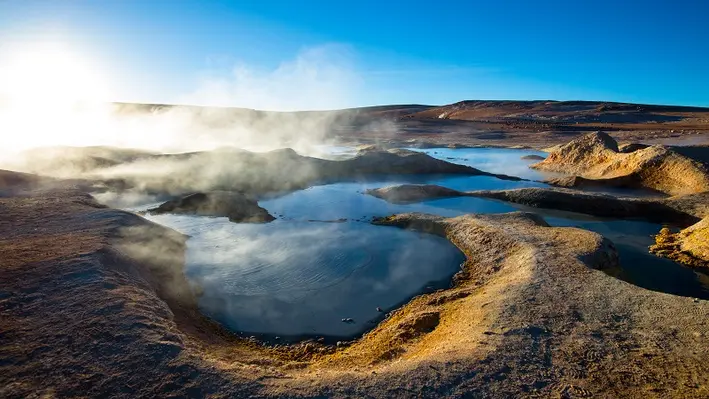
 GreenFire Energy Inc. and Stoic Transitional Resources have announced a pioneering collaboration effort for innovative geothermal energy solutions.
GreenFire Energy Inc. and Stoic Transitional Resources have announced a pioneering collaboration effort for innovative geothermal energy solutions.
Through a cross-license agreement that covers GreenFire’s patented GreenLoop technology and Stoic’s patent-pending Flux Crossover, the companies will focus their efforts on repurposing existing oil and gas wells and non-productive geothermal wells to harness the potential of geothermal energy.
GreenFire’s Greenloop technology is a closed loop advanced geothermal system which provides solutions that assure the availability of resilient, sustainable and scalable geothermal energy for a range of applications, including power and direct use heating and cooling. The Stoic technology aims to enhance the GreenLoop performance.
Stoic’s Flux Crossover combined with the GreenLoop technology will enhance performance by optimising flow patterns, minimising parasitic heat loss and double heat transfer efficiency. The two companies announced a partnership last year for the development of geothermal projects through utilising abandoned wells in New Zealand and Canada.
Steven Brown, President of GreenFire Energy Inc., said, “We are pleased to be collaborating with Stoic Transitional resources. GreenFire Energy’s technology has the capability to economically repurpose idle geothermal wells and expand implementations in geothermal fields. Collaborating with Stoic’s technology will enhance performance and broaden GreenFire Energy’s solutions.”
Joe Tarrant, Co-Founder and Chief Commercial Officer at Stoic, commented, “Our commitment extends beyond innovation to fostering sustainable partnerships and empowering communities. Stoic’s pioneering approach to clean energy aligns perfectly with our mission, emphasising the value proposition for data centre customers.”

 With the race to a net zero future continues to heat up across the globe, more eyes are turning towards geothermal methods as a suitable alternative for energy. While the US continues to dominate the word stage when it comes to geothermal production, there is a giant lying under the surface across the Asia Pacific.
With the race to a net zero future continues to heat up across the globe, more eyes are turning towards geothermal methods as a suitable alternative for energy. While the US continues to dominate the word stage when it comes to geothermal production, there is a giant lying under the surface across the Asia Pacific.
With Indonesia boasting a predicted capacity of 27GW, and both the Philippines and New Zealand ramping up their installed capacity year-on-year, APAC has become one of the key global players in the geothermal game, already producing 35% of geothermal generation worldwide.
However, the burning question that faces the region is do the myriad of issues presented by factors such as limited resources, a lack of governmental funding and a challenging topography to contend with mean that the colossal potential lying underground will have to remain as such, rather than be utilised as a fruitful source of energy?
As the majority of geothermal resources are associated with volcanic activity in high terrain, exploration projects become more challenging and require additional resources and infrastructure, such that the region may not have access to. Financial stability is also a crucial factor waging a war against the utilisation of geothermal energy throughout APAC as the resource is not necessarily a commercial viable option for many operators.
Nevertheless, measures are being put into place to mitigate against these challenges, with government policies changing to accommodate green energy funds and private sectors and investing higher sums into the industry, there is a hope of prosperous future.
The Asia Pacific Geothermal Transition Outlook attempts to analyse the key players within the region and outlines where the pitfalls and mitigations lay ahead of the inaugural GTS APAC 2024 conference in Jakarta from 9-10 July.
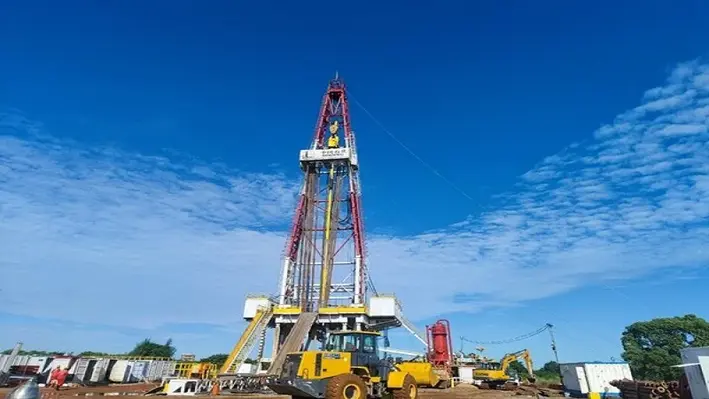
 In a breakthrough exploration of 250mn-year-old granite in South China, China Petroleum & Chemical Corporation (Sinopec) has completed the drilling of Fushen-1 Well in Hainan.
In a breakthrough exploration of 250mn-year-old granite in South China, China Petroleum & Chemical Corporation (Sinopec) has completed the drilling of Fushen-1 Well in Hainan.
At 5,200 m, it is the deepest geothermal exploration well in China.
Started in last August, the company notes this as a milestone reached in less than a year.
This has been made possible by Sinopec's deployment of several independently developed innovative technologies, including the combination of dual-drive drilling and high-pression injection, to reach the temperature limit of hot dry rock stipulated by the national energy industry standards, while forming the key technologies of detection and evaluation of deep geothermal resources.
Sinopec's next steps will include extensive research and field tests at Fushen-1 Well, building the first platform that brings together research, education, and experimentation of deep geothermal in South China. This will help formulate theoretical methods and technical systems applicable to the region, paving the path towards the country's 'Dual-Carbon' goal.
China's geological surveys have revealed that the hot dry rock geothermal resources within the range of 3 kms to 10,000 m underground in China's land area are equivalent to 856 trillion tons of standard coal. Every 2% of them equals 2,993 times the annual energy consumption of China in 2023. The country has an accumulated geothermal heating capacity of nearly 100 mn sq m with several multi-million-square-meter regional geothermal heating projects already built and in operation.
Page 7 of 14
Copyright © 2025 Offshore Network